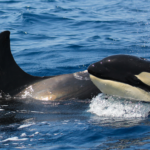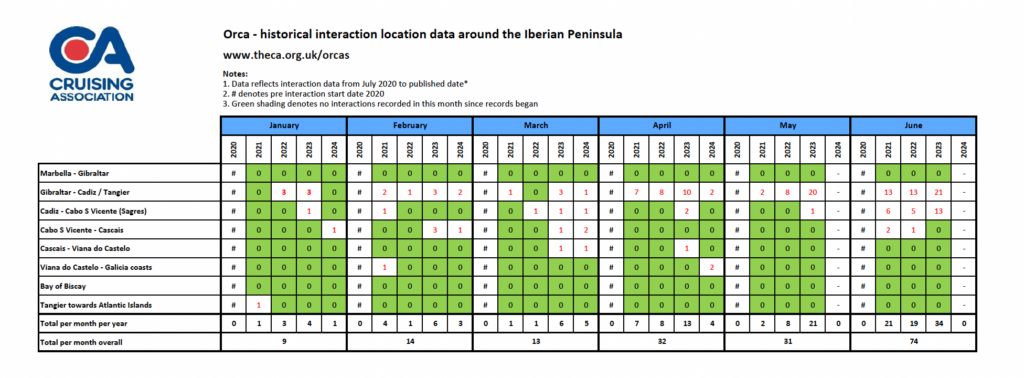
New data on orca attacks and interactions released

The Cruising Association (CA) has analysed available orca interaction reports since 2020 to produce a new table showing locations by year and month along the Atlantic coasts of France, Portugal, Spain and through the Strait of Gibraltar. Skippers can review this table when planning to sail through the specific areas of coastline affected by orca interactions and attacks.
The CA has produced the table using data from the monthly interaction maps produced by Grupo Trabajo Orca Atlantica (GTOA), the best available resource of interactions since the phenomenon started but still not a 100 per cent accurate record.
The table also highlights some (occasionally significant) variations from year to year and so does not guarantee the best chance of avoiding an interaction. The CA advises that when planning to sail through the affected area, sailors should use the GTOA monthly interaction maps and the CA summary table to review the pattern of interactions from previous years. Then when on passage use GTOA’s current activity app, GT Orcas to stay informed of where interactions are happening.
Ideally, the CA advises sailors to plan passage routes to avoid known danger zones and review the CA’s dedicated orca information and reporting portal, which provides a wide range of resources in English, French, Portuguese, and Spanish.
Orca interaction figures
The orca population feeds on Atlantic bluefin tuna and follows its migration pattern. In early summer when tuna movement around the Strait of Gibraltar is at its peak, the orca population concentrates in this area before spreading west and north with the tuna. As the tuna migration progresses, different orca families move to different areas. Some stay around the Strait; others appear to have their own favoured areas, as much of the population disperses to the north and into deeper water. During winter they regroup towards the Strait of Gibraltar.
Historically, interaction numbers have been relatively low between December and March, but not many yachts transit the affected area during this period.
Interactions and orca attacks occur across the widest geographical area from July to November. Numbers are at a peak between June and September and tail off during October and November.
The table highlights in green where there have been no interactions in that section of coast by year and month. Since the phenomenon began, with a single exception, the only recorded interactions in any section of coast during May are in the Strait of Gibraltar.


Orca in Strait of Gibraltar
The Strait of Gibraltar is also the area with the highest number of interactions. However, observations since 2020 have established that transiting this area in the shallow water route along the Spanish coast presents a minimal risk. According to skipper reports submitted to the CA, only one of 161 interactions was in water depth of 20m or less.
There continues to be much discussion of the shallow water route (mostly in water depth of 20m or less) on social media (including current locations of the fixed tuna nets and which can be passed to landward). Skippers must take the usual precautions for shallow water sailing, taking account of fixed tuna nets (some extend from the shoreline), tides, hazards and weather conditions.
No interactions or orca attacks in the Strait of Gibraltar have been recorded in September. North of Lisbon there have been no recorded interactions in May or June, but it for the first time in April 2024 there have been interactions in that area.
Advice on orca attacks
The CA continues to share information on precautions to minimise the risk of encounters and provide guidance on actions to take if an encounter occurs. Most yachts do avoid orca encounters, but understanding risks and knowing how to minimise the likelihood of an interaction is crucial.
Skippers should be familiar with the CA checklist, risk reduction and deterrent measures and follow the recommended safety protocol on the website.
Keep continually up to date with the GTOA’s interaction and sightings app, GT Orcas, along with Orcinus, each of which record current activity. The GTOA traffic light risk map warning system covers all affected areas and is based on recent interactions and locations.
Orca identity
According to the CA, the responsible orca mostly belong to the Strait of Gibraltar and Gulf of Cadiz Orca sub-population which is less than 50 strong, plus a few orca of unknown origin that associate with this population. Around 15 of this population have been responsible for the interactions.
The CA would like to establish whether there is any correlation between the location of an interaction and the level of damage caused. If certain orca favour different locations away from the Strait of Gibraltar, is it possible that some cause greater levels of damage than others? But the association says many more detailed reports are required before it is possible that a pattern may be identified (if at all). GTOA publishes information on the orca population at www.orcaiberica.org/en/catalogo.
Submit an orca report
While the GT orcas app plays a vital role in promptly reporting orca sightings and interactions, skippers are urged to also submit reports to the CA reporting portal. This portal facilitates the detailed monitoring orca of interactions and uneventful passages. Without these reports, critical information regarding changes in orca behaviour or the efficacy of deterrent measures would be unavailable to sailors and scientists.
The CA has extracted data from the reports to publish an interaction comments library, which categorises skipper actions, such as using noise, sand, reversing or sailing/motoring away and identifies different deterrent strategies. The CA also publishes comparative data presenting statistics from interaction reports and uneventful passage reports side by side.
Boaters can submit reports on interactions or uneventful passages through areas of interactions to assist the CA in developing its resources www.theca.org.uk/orcas.
The post New data on orca attacks and interactions released appeared first on Marine Industry News.
